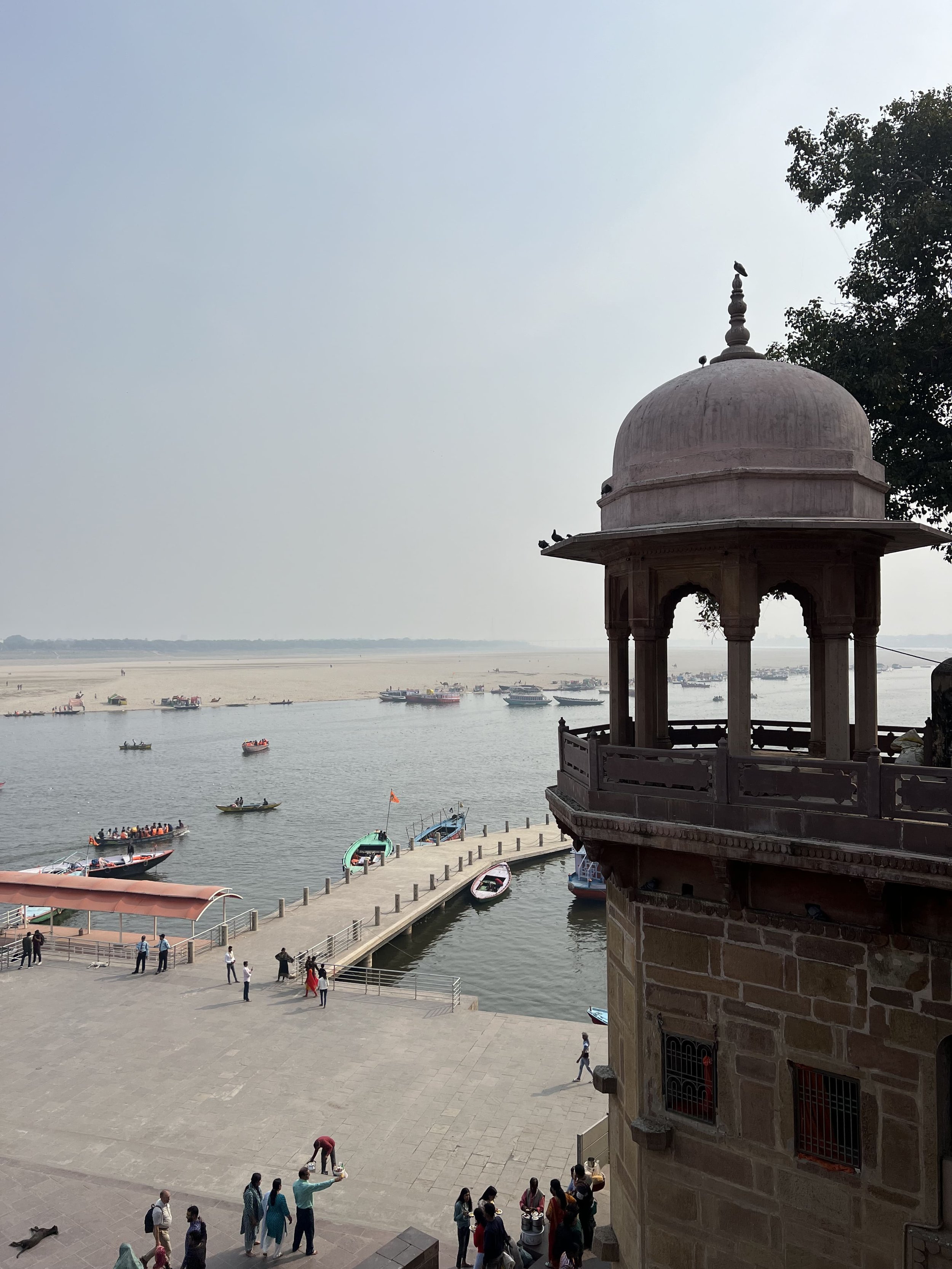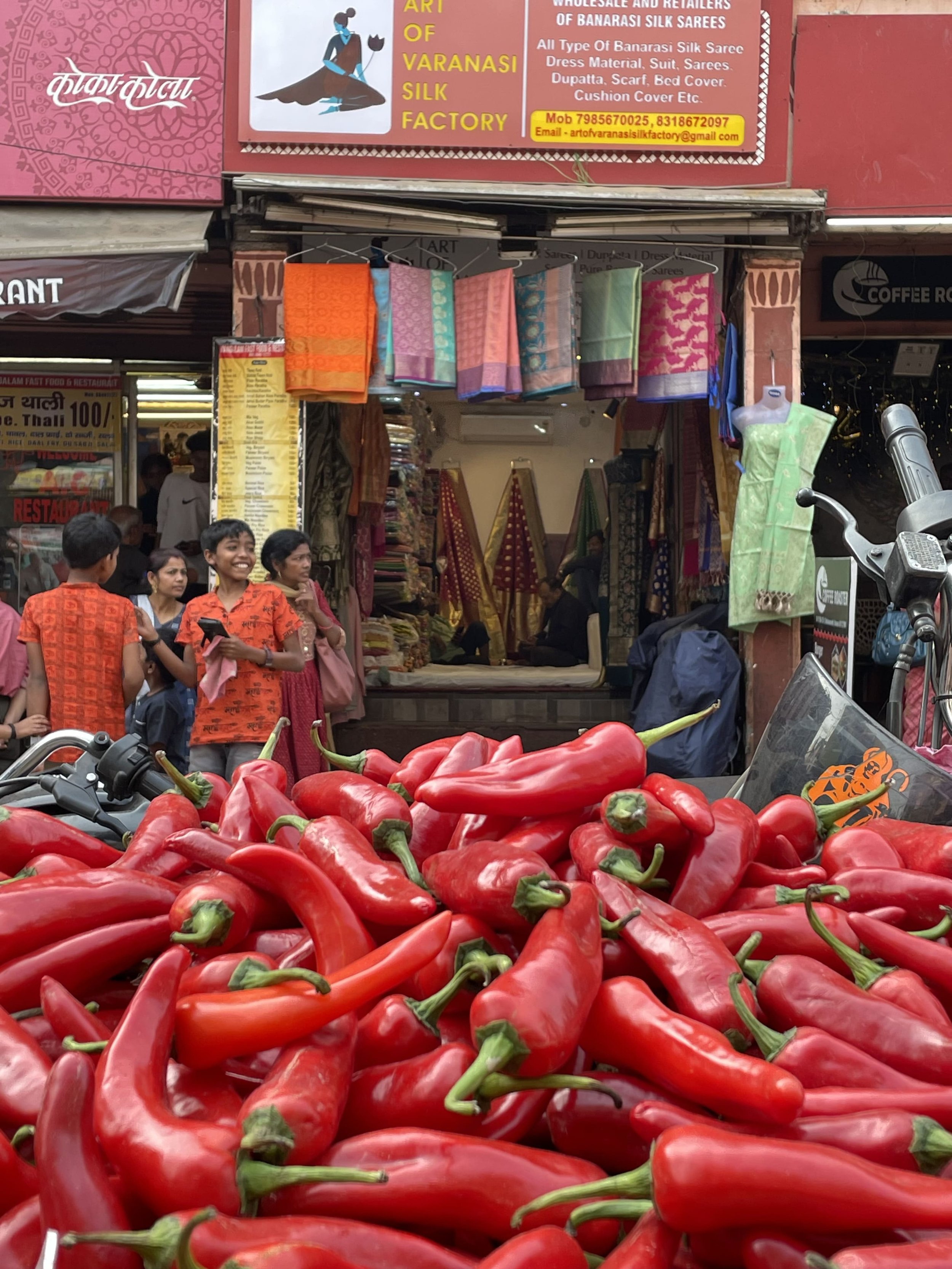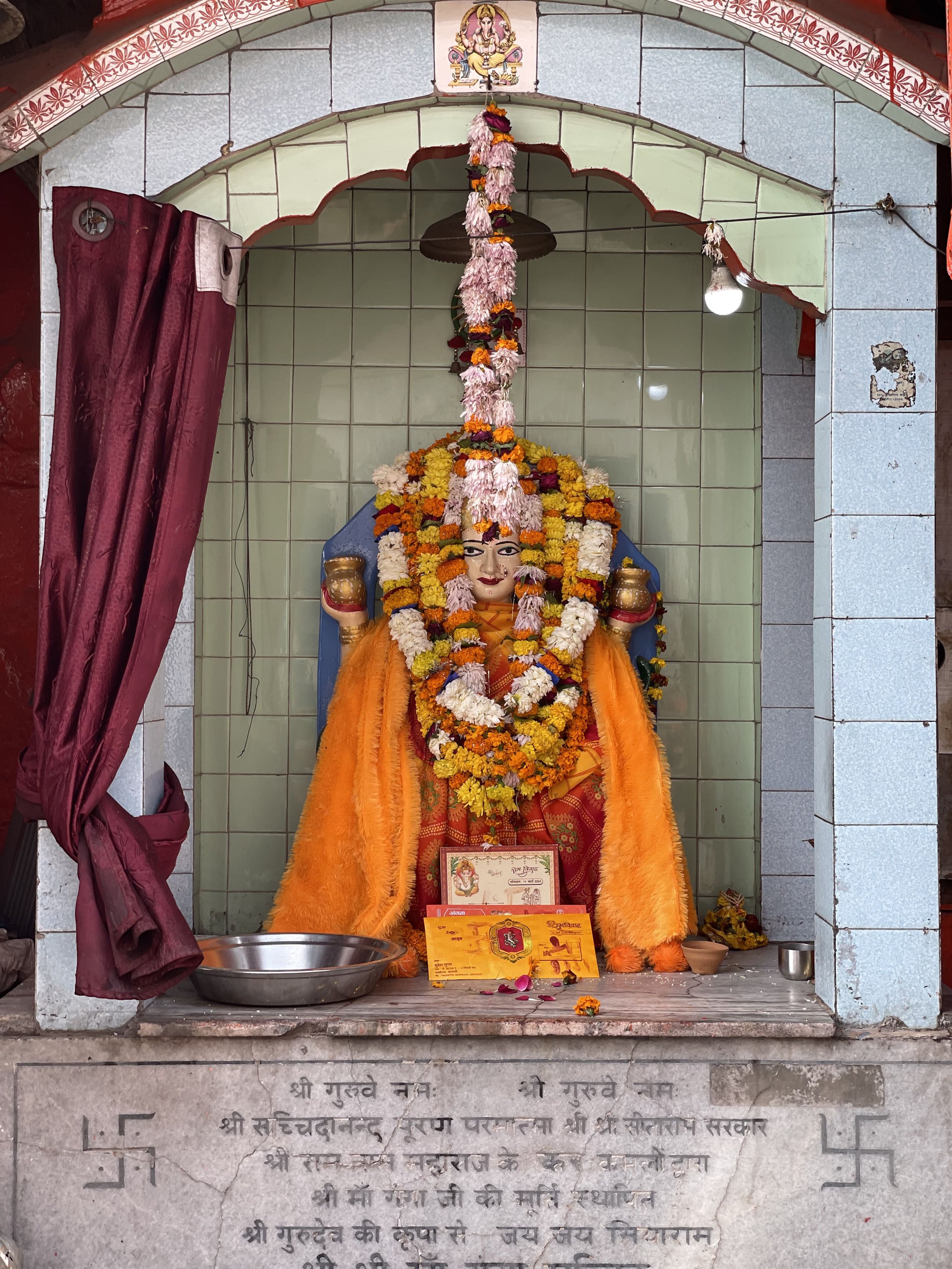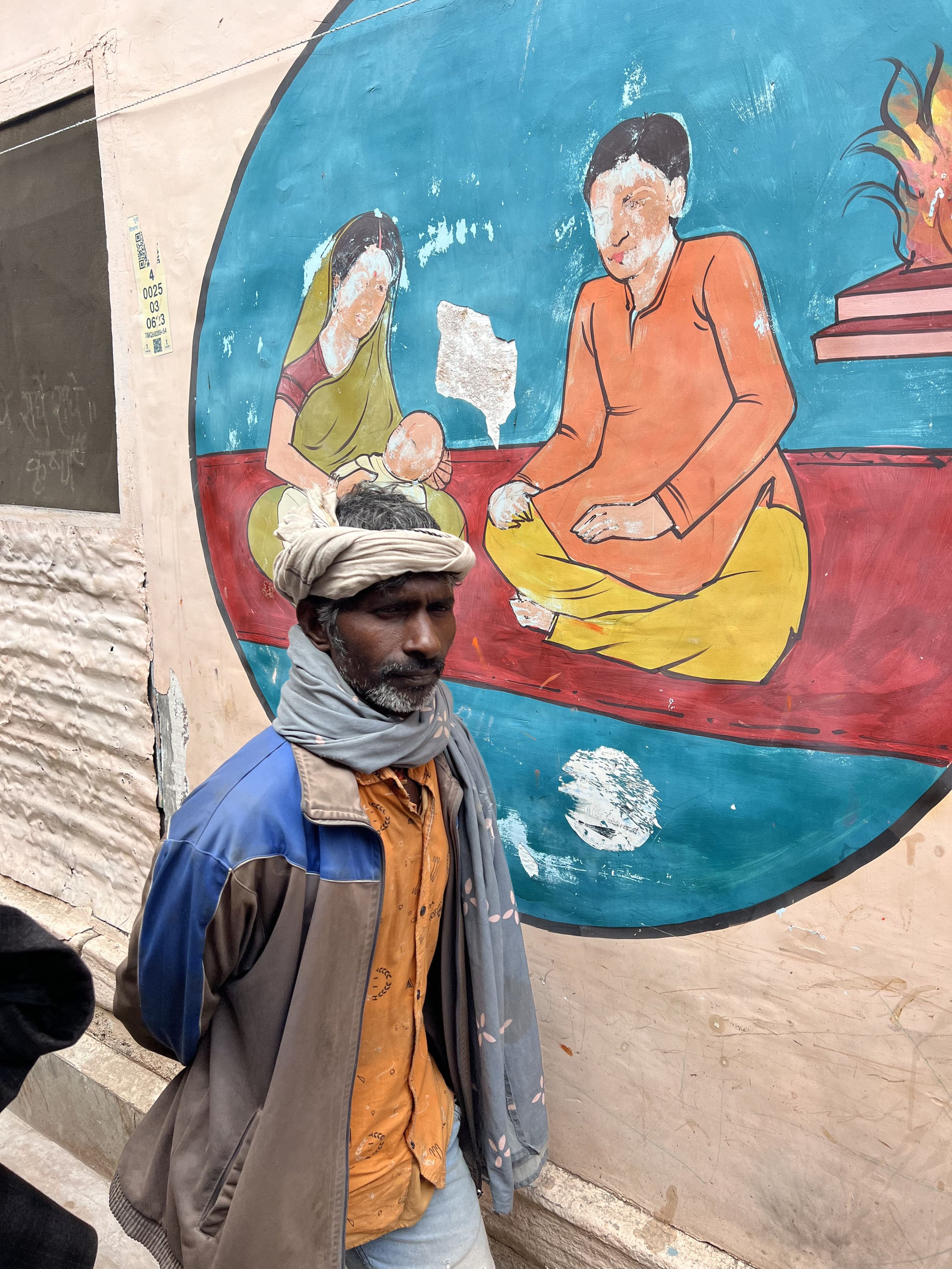Varanasi
The holy city and its ritesThe usual way to get to Varanasi is by train after visiting Agra. But after a thorough search and doing the research that characterises @tripticity_, trips, we decided to skip the experience and prioritise comfort over adventure.
Although the alternative was not as advisable (as it implied a car journey to Delhi and from there taking a plane) we considered that it would be more efficient than spending the night on a train.
So we arrived in the holy city on a Sunday night. The smog was impossible, so much so that we got an alarm on our phone from the weather app alerting us as to the unhealthy air. The streets, of course, were buzzing with people.
Manish, the guide waiting for us, spoke very limited English and kept coughing. Back in our country, while the cough was still with us, it was impossible to forget the friendly Manish.
Together with the driver, he drove us to a point in the city centre, where he stopped and made us get out. There we met the hotel luggage men, who were waiting to accompany us on what seemed like a ten-minute film shoot, passing through the market, the chaos of motorbikes, monks returning from the Ganges, plus a dozen other crazy situations. I even got hit by a motorbike which, when it backed up, hit me like it was nothing.
As it happens, our accommodation was right in front of the Ganges, next to the main Ghat and its usual access is usually by boat. But our arrival after 10 p.m. forced us to make the five-block journey to the ancient fort.
The next day, when we walked the same road, we noticed that at night there were far fewer people, even though we thought it was crowded.
During the day, the public road was absolutely and literally packed with vendors, beggars, cows, motorbikes, tourists, cyclorickshaws, monks, worshippers, dogs. Again: an overdose of everything, of the world.
The porters were guiding us, dragging our suitcases through the dirt of those paths, those streets.
Our visit to Varanasi was at the end of our journey through India. By then, we felt immune to the filth, but it was only a matter of time before we realised that the subcontinent still held much to amaze us, so we had to be on our guard.
On arrival at the Brijrama Palace we were welcomed with a necklace for good fortune. As we settled into our room we were grateful that we had opted for this superior hotel, conveniently located right in the centre of the holy city. In the room a metal vessel contained water from the holy Ganges, which was also offered to us as a gift to take back with us. This is the Kalash of Gangajal, which is given to pilgrims.
The luxury hotels in Varanasi are on the outskirts, except for the Brijrama. The extra we paid for this accommodation was a very wise decision. Not only because a visit to the city is to experience the spectacle of life and death at first hand, with all the difficulties that entails, so that returning to a bed of pristine white sheets felt like heaven, but also because it was enough to walk just a few steps to be in the very heart of the sacred epicentre.
Early in the morning, I took up the yoga practice offered by the hotel right at sunrise led by Ved Prakash Pathak.
The breakfast buffet was very varied and we were treated to typical local sweets such as the delicious jalebi sweet or malaiyo, a fresh saffron-flavoured milk foam.
After breakfast, we met Prince, who guided us around the city.
Our local guide's proposal was to walk through the passages, its narrow streets, where tourists don't go, in order to get to know the daily customs and the rhythm of its people.
So that day we walked up and down stairs for about ten kilometres through the alleys and markets of the old town, in a zigzag that felt like being inside a labyrinth. In some of these alleys there wasn't even a signal, so Google Maps was not an option. We had to follow Prince and not lose him. We were at his mercy.
We passed stalls of all kinds, selling wedding items, from suits, fabrics and all kinds of ornaments, selling food, sweet, savoury and spicy curries or the classic masala chai, tea with milk and spices. In these stalls, milk was boiled in giant metal pots, while cows passed by without burning or spilling it. Only in India.
We then drove to Panchganga Ghat to visit the city's mosque, before heading to the Manikarnika crematorium to witness the ceremony. There, no grief reigns as it does at a Western funeral wake. The dead's relatives even seem to take pride in performing such a significant ritual, to the point that they even make video calls with the fire of the pyre behind them. There is no bad smell either. I do confess that I insisted to Mr @tripticity_ that he shut his mouth because the ashes were flying everywhere.
The initial shock of some impression gave way to that other sensation of understanding that everything in India is different. Life, death, beliefs, everything. For Hindus, a cremation in the Ganges means cutting the cycle of reincarnations, in other words, reaching the maximum in terms of spirituality. We sat on some very dirty steps and just witnessed the whole scene, respectful not to take pictures as Prince pointed out to us.
We continued with another walk through the markets back to the hotel for a long awaited short break, both for the legs that were feeling the din of the circuit, and for the spirit and mind after all that we had experienced.
The hotel also offered a complimentary high tea. Eating a western flavoured, spice-free crumb sandwich was glorious. We enjoyed it thoroughly in preparation for the second leg of the tour. At six o'clock in the evening, at the main Ghat called Dasaswamedh, where the Aarti ceremony takes place every day.
Varanasi is one of the most mythical cities in India, Helena from Black Pepper Tours had told us, but experiencing it is nothing like what we had read or heard.
Prince looked us up and gave us the options to watch the ceremony. Either we paid for a plastic seat on a terrace or in a boat, or we sat on the steps next to the locals. Helena had recommended the latter option in order to get a close-up feel for everything, so that's what we did. There Prince explained a bit about the ritual and then left us to witness it in solitude. It lasted about fifty minutes. What perhaps caught our attention the most was how the local public experiences this ritual of Hindu priests, who perform their prayers while lighting fires and burning incense. The faithful - for their part - generously offer their donations in money to the priests who pass by collecting them.
When it was over, we returned to the hotel. In the inner courtyard there was a beautiful folkloric show.
In the evening we dined in the comfort of the hotel restaurant, which is strictly vegetarian as it is situated on the banks of the holy Ganges. Alcohol is not offered there under any circumstances.
Early in the morning we planned to take the early morning boat ride on the river, water level permitting. The water was fine... but the tremendous storm made it impossible to take it. That gave us a few more minutes of rest in our room before Manish told us that we were ready for the boat ride, which consists of sailing down the river, seeing the ghats one by one and passing right in front of the two crematoriums, the main one and the secondary one further away. The main and most picturesque ghats are Kedar Ghat, Assi Ghat, Bachraj Ghat and Hanuman Ghat. In these morning hours, pilgrims perform their purifications in the water and make their offerings.
Back at the hotel, we enjoy the tremendous breakfast at the Brijrama and get ready for the transfer out. Before we left, Rajnikant, the hotel astrologer, recited a mantra blessing us while putting red and orange strings on our left wrist. He then presented us with a book on Hinduism.
Around midday we took the boat to a car park on the outskirts where Manish was waiting to take us to the airport for our flight to Delhi, perhaps too many hours in advance. We didn't want to question our agency as we understand that one should be cautious before flights... but it happened to us that we spent too much time waiting at the airports during our trip through India.
And so, once again travelling along the sacred Ganges, we left the legendary Varanasi, feeling proud because a trip to India should include this destination, a reason to consider, or rethink, the notions of life and death.












































































































